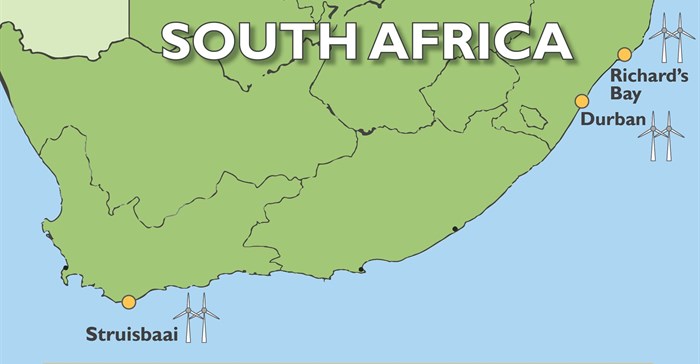






“If we were to install wind turbines at different depths off the KwaZulu-Natal and Western Cape coast, they could potentially supply approximately 15% and 800% of South Africa’s annual electricity demand,” say Gordon Rae and Dr Gareth Erfort from the Department of Mechanical and Mechatronic Engineering at Stellenbosch University.
They used geographic information system methods to do the first comprehensive assessment of South Africa’s offshore wind energy resources and to identify the most suitable regions for the development of wind farms. Their assessment included marine protected areas sourced from the World Database of Protected Areas, which is the most comprehensive data-base on terrestrial and marine protected areas. The researchers say they included marine protected areas in the study to create what they call no-go zones.
“It was important to include these no-go zones as they illustrated to us what portion of the exclusive economic zone would be inaccessible to offshore wind energy from an environmental perspective," they say.
The researchers say their assessment showed that the most suitable regions for the development of offshore wind energy are Richards Bay (within the 10km coastline buffer and approximately 15km offshore south of Richard Bay), Durban (within the 10km buffer & approximately 25km offshore of KwaDukuza) and Struisbaai (within the 10km buffer zone and approximately 15km offshore).
“Our study revealed that South Africa has an annual offshore wind energy production potential of 44.52 terawatt hours (TWh) of electricity if wind turbines were to be installed in shallow waters (depths of less than 50 metres) and 2,387.08TWh with wind turbines in deeper waters (depths less than 1,000 metres)," they say.
According to Eskom, a typical South African household uses about 30 kilowatt hours (KWh) per day or 10,950KWh per year, which means that 44.52TWh could technically power approximately four-million average households annually. Similarly, 2,387.08TWh could power roughly 218-million average households per year.
“Considering that South Africa’s annual electricity consumption is approximately 297.8TWh, our calculations show that the estimated annual energy production (AEP) available through 44.52TWh could theoretically meet 14.9% of our national electricity demand. Similarly, the estimated AEP available through 2,387.08TWh could theoretically satisfy the country’s annual electricity demand eight times over.”
These figures show that we should not ignore the significant potential of offshore wind energy, especially if we consider the International Energy Agency’s prediction that global electricity demand will increase by approximately 56% by 2050, say the researchers.
According to them, assessing offshore wind energy resource is essential for the development of local offshore wind industries.
“Quantifying these resources is a fundamental first step for the development of markets for offshore wind energy, and offers valuable insight for the planning of energy security at national level and private sector investment.
"South Africa’s ageing coal power fleet will gradually be decommissioned over the next 30 years. This creates an opportunity for a transition to offshore wind technology which is a clean electricity generation alternative that presents great power security and decarbonisation opportunity for South Africa.”
The researchers mention that South Africa is still lagging behind in the development of offshore wind energy at a time when the industry is on the rise globally, with significant growth occurring in Europe and Asia.
“Although the Renewable Energy Independent Power Producer Procurement Programme was launched in 2011 to procure renewal energy projects, it is yet to exploit or consider the abundance of offshore wind energy resources available.”
By tapping into these resources, South Africa could also decrease its carbon emissions significantly, add the researchers.